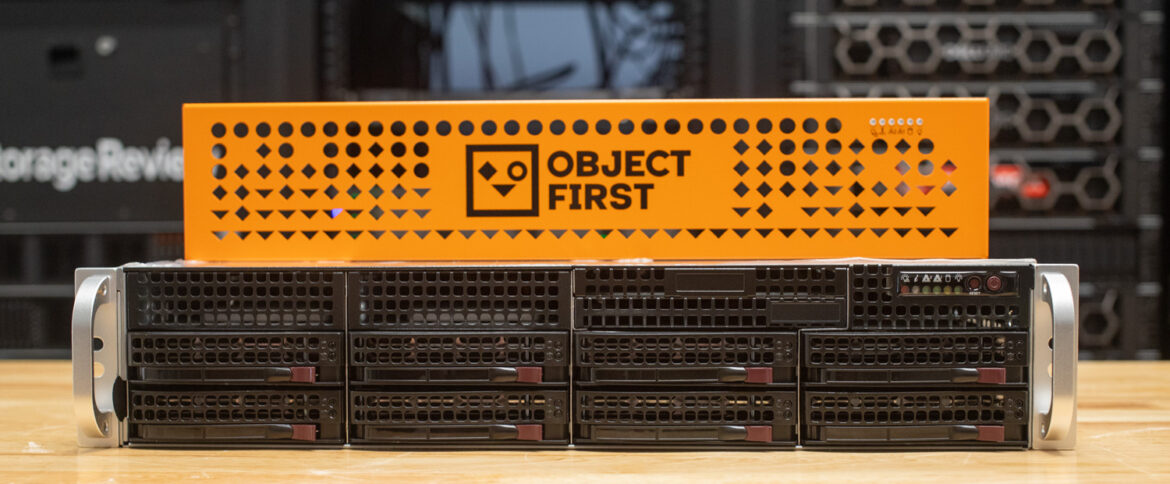Explore how Object First’s Ootbi appliances deliver simple, scalable, immutable backup for Veeam, from 20TB edge units to 432TB enterprise systems.
In our previous deep dive into Object First’s Ootbi (Out-of-the-box immutability), we explored how the company was redefining backup storage for Veeam, focusing on the platform’s core principles: security, simplicity, and power. Since that review, Object First has expanded its product line and key capabilities. The Ootbi platform now includes new models at both ends of the spectrum: compact 20 TB and 40 TB units designed for mid-sized enterprises and a powerful 432 TB appliance delivering up to 8 GB/s data ingest speed (on a four-node cluster) for large-scale environments. Object First has also rolled out S3 performance optimizations for third-party data movers. With support for mixing and matching appliances, clusters can now scale up to 1.7 PB of usable storage capacity and up to 7 PB in Veeam scale-out backup repository (SOBR) configurations. All while preserving the platform’s core principles.
Object First’s momentum has translated into real market success. The company reported a 167% year-over-year increase in global bookings in Q1 2025, a strong indicator that its strategy of delivering secure, immutable backup storage purpose-built for Veeam is resonating with enterprise and mid-market customers. While the primary mission is to simplify secure backups as the best defense against threats like ransomware, Object First has also been developing tools to help partners and customers identify the appropriate hardware for their environment. To help organizations better plan and size their backup infrastructure, Object First also introduced a Backup Storage Calculator that estimates capacity needs based on retention policies, workloads, and growth expectations.
To provide more flexibility for customers to adopt Ootbi, Object First recently introduced a new consumption-based model for its appliances, offering users and service providers greater flexibility in deploying and scaling backup storage. Initially available in the U.S. and launching in EMEA in September 2025, this model removes the need for upfront capital investment and aligns costs with usage, making ransomware-proof storage more accessible to a broader range of organizations. This is especially applicable to service providers, who benefit from the ability to scale on demand and manage costs more predictably. The move reflects Object First’s ongoing focus on simplicity and value, particularly for partners managing multiple Veeam environments or seeking to standardize their secure backup infrastructure.
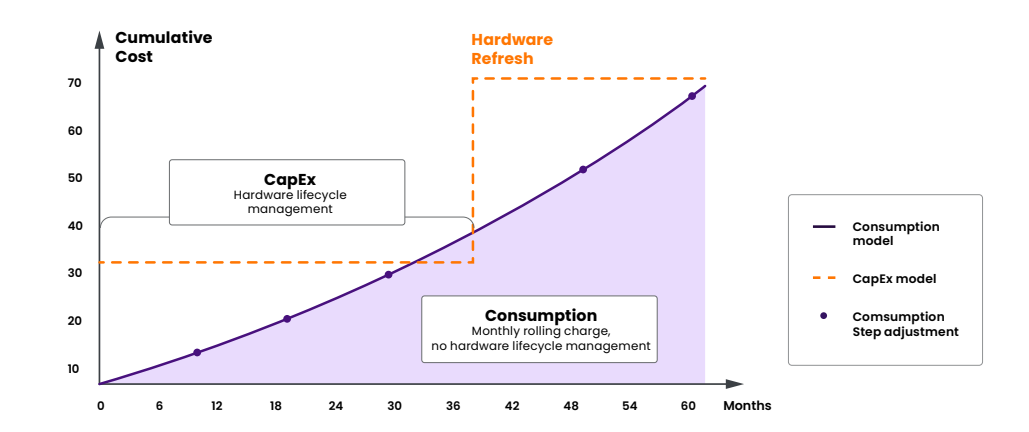
In addition to all of this, they’ve released Ootbi version 1.6, which brings a broad set of updates across security, system management, and Amazon S3 service performance. Notable improvements include enhanced access rights for limited S3 roles, optimizations to internal metadata handling that reduce response times, and better resiliency for multinode clusters when nodes go offline. The TUI and Web UI have both received usability improvements, with fixes to disk replacement workflows, expanded logging options, and more thorough cleanup during node resets. The release has brought improved monitoring, IPMI polling, and refined syslog messaging. Additional details and more information on the 1.6 release can be found on the Object First Help Center.
Expanded Hardware Lineup
Object First has introduced two new Ootbi appliance models targeting three distinct segments: 20 TB and 40 TB options for small to medium enterprises, and a new high-capacity 432 TB appliance designed for large-scale enterprise environments. With these additions, a four-node cluster can now scale up to 1.7 PB of usable capacity and over 7 PB as extents in a Veeam Scale-Out Backup Repository (SOBR).
The smaller models are ideal for small to medium-sized businesses (SMBs) and edge deployments that require secure, cost-efficient backup solutions. This expanded lineup also enhances flexibility and value by allowing customers to mix and match appliances within existing clusters. The 20 TB and 40 TB Ootbi appliances are particularly well-suited for Remote Office, Branch Office (ROBO), and edge deployments where space, power, and local IT resources may be limited. These compact models deliver the same core benefits as their larger counterparts: immutability, simple setup, and seamless Veeam integration, but in a smaller footprint that is easy to deploy in distributed environments. Managed service providers can also benefit from these models by deploying them across client locations as dedicated backup nodes while centrally managing recovery workflows through Veeam’s Scale-Out Backup Repository (SOBR) feature.
Organizations with multiple small sites or departments can mix these lower-capacity appliances with larger models as part of a unified backup strategy. This flexibility ensures that even the smallest environments can adopt Zero Trust data resilience practices without overprovisioning while still benefiting from rapid recovery performance and immutable protection. In these scenarios, Object First delivers a scalable and consistent storage experience that aligns with the demands of both enterprise and mid-market customers.
Below is a detailed breakdown and comparison of the small (20 TB/40 TB), medium (64 TB/128 TB/192 TB), and large (432 TB) Ootbi appliances Object First offers, highlighting differences in storage configuration, performance, form factor, and power requirements to help match deployment needs across various environments.
| Appliance Specification | 20 TB, 40 TB | 64 TB, 128 TB, 192 TB | 432 TB |
|---|---|---|---|
| Maximum Nodes Per Cluster | 4 | 4 | 4 |
| Ingest Speed | 1GB/s | 1GB/s | 2GB/s |
| Primary Array | 7 × 4 or 8 TB HDD (RAID 6) | 11 × 8, 16, or 24 TB SAS HDD (RAID 6) | 22 × 24 TB HDD (RAID 6) |
| Hot Spare | 1 × 4 or 8 TB HDD | 1 × 8, 16, or 24 TB SAS HDD | 2 × 24 TB HDD |
| Dedicated OS Disks | 2 × 240GB SATA (RAID 1) | 2 × 240 GB SATA SSD (RAID 1) | 2 × M.2 480 GB (RAID 1) |
| Cache | 800 GB Enterprise NVMe | 1.6 TB Enterprise NVMe | 1.6 TB Enterprise NVMe |
| Form Factor | 2U Rackmount | 2U Rackmount | 2U Rackmount |
| Dimensions (W x H x D) | 17.2” × 3.5” × 25.5” (43.7 cm × 8.9 cm × 64.8 cm) |
19” × 3.5” × 25.5” (48.3 cm × 8.9 cm × 64.8 cm) |
19” x 3.4” x 33” (48.2 cm x 8.7 cm x 83.7 cm) |
| Weight | 52 lbs / 24 kg | 75 lbs / 34 kg | 103 lbs / 46.3 kg |
| Network Interface | 2 x 10GbE Base-T or 2 x 10GbE SFP | 2 x 10GbE Base-T or 2 x 10GbE SFP | 2 x 10/25GbE SFP28 |
| Management | Dedicated IPMI 2.0 – RJ45 | Dedicated IPMI 2.0 – RJ45 | Dedicated iDRAC RJ45 |
| Total Output Power | 2x Redundant (1+1), 800 W (100-240v AC) Titanium | 2× Redundant (1+1), 1000 W / 1200 W | 2x Redundant (1+1), 1100 W MM (100-240v AC) Titanium |
| Power Cables | Region-specific power cables included | Region-specific power cables included | Region-specific power cables included |
| Idle / Backing Up / Max Peak | 195 W / 250 W / 314 W | 252 W / 400 W / 540 W | 415 W / 620 W / 969 W |
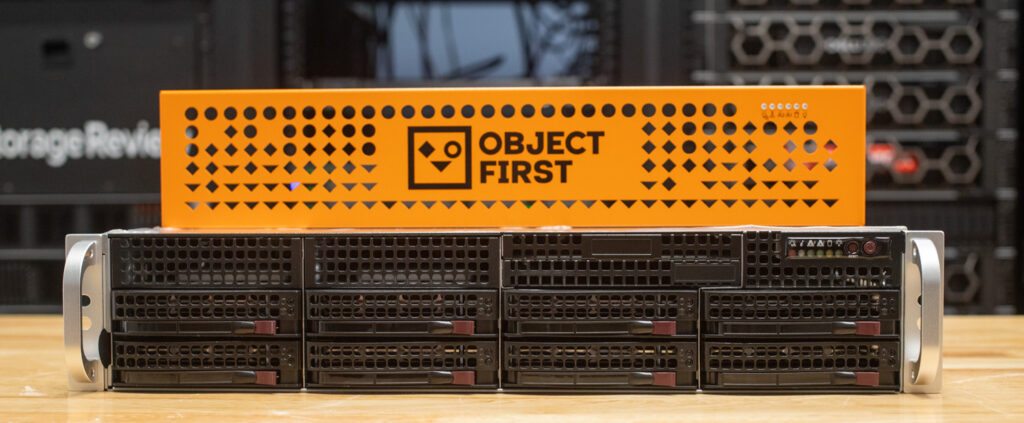
Starting with the 20 TB and 40 TB Ootbi appliances, these are built on a Supermicro 2U chassis, designed to deliver compact and reliable backup storage for small to medium enterprise environments. They utilize 7 × 4 TB or 8 TB HDDs in a RAID 6 configuration, with a single 4 TB or 8 TB hot spare for redundancy. The system features two dedicated SATA SSDs for the operating system, configured in RAID 1 for redundancy and failover protection. Each unit is equipped with an 800 GB enterprise-grade NVMe drive for caching and accelerating performance. Networking is handled by dual 10G Base-T or SFP+ interfaces, providing flexible connectivity options. Like the larger models, it features a dedicated IPMI 2.0 RJ45 port for out-of-band management.
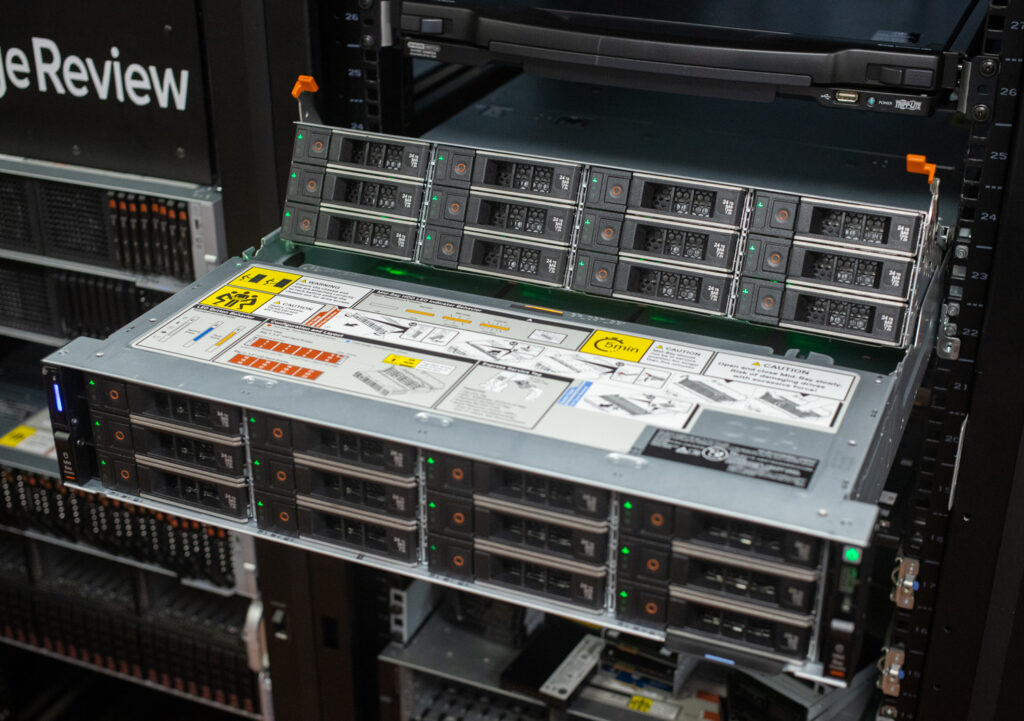
The new 432 TB Ootbi appliance is built on a 2U Dell PowerEdge R760XD2 chassis, supporting 22 high-capacity 24 TB 12 Gbps SAS drives in a RAID 6 configuration with two hot spares. For caching, the system includes 1.6 TB of enterprise-grade NVMe storage. Networking is managed through a dual-port 10/25 GbE SFP28 interface, offering up to 50 Gbps of potential throughput. Additionally, the system includes a BOSS N1 controller card with dual M.2 480 GB SSDs for the boot OS, configured in RAID 1 for redundancy. The chassis is shipped without a front bezel to enhance airflow and improve cooling efficiency across the drive array.
StorageReview Lab Testing & Validation
To validate the performance and capabilities of the newly expanded Ootbi lineup, we evaluated the 432 TB model in our lab environment. Object First sent us both the 20 TB and 432 TB appliances specifically for testing, and we integrated them into a real-world backup scenario to assess their functionality at scale.
As part of our internal infrastructure, we recently launched a StorageReview Community Discord VPS, offering virtual machine resources to our community members. This environment is hosted on a Proxmox-based virtual infrastructure and currently comprises approximately 15 virtual machines running a mix of Windows Server and Ubuntu Linux installations. These VMs handle various tasks, including hosting game servers, LLM inference testing, monitoring, and web development workloads.
For backup validation, we leveraged Veeam’s native integration with Proxmox, backing up these virtual machines directly to the 432 TB Ootbi appliance, which was configured as an S3-compatible repository. This setup enabled us to test ingest speeds, ease of integration, S3 compatibility, and backup performance under mixed load conditions. It closely simulates a real-world multi-tenant or lab operations environment.
Ootbi Setup and Configuration
Installing the new 432 TB Object First Ootbi appliance in the StorageReview lab reaffirmed one of the platform’s greatest strengths: simplicity. The entire process took just a few minutes from unboxing to full integration. Object First ships each unit with a laminated quick-start guide, guiding users through the initial setup and configuration process. While we had an Object First engineer on standby during installation, the process was so straightforward that we could have easily completed it without assistance.
When you first power up your Object First Ootbi appliance, you are presented with a CLI where you can assign system IP addresses for the different network interfaces. This stage takes just a minute or so. After the IP addresses are saved, setup moves over to the traditional Web GUI.
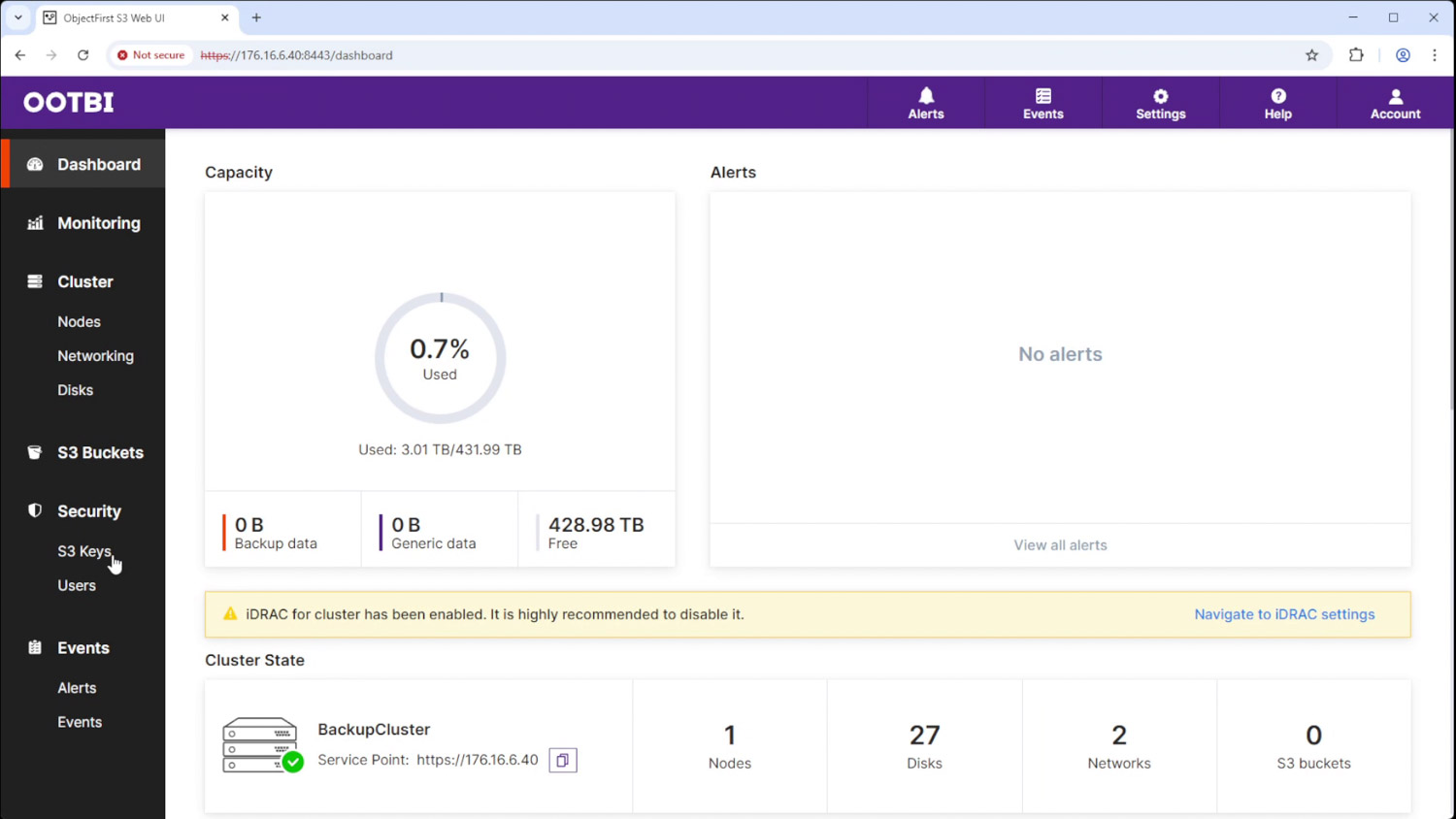
The first step you need to perform at this stage is creating an S3 Key, which Veeam will use to connect to the Ootbi appliance.
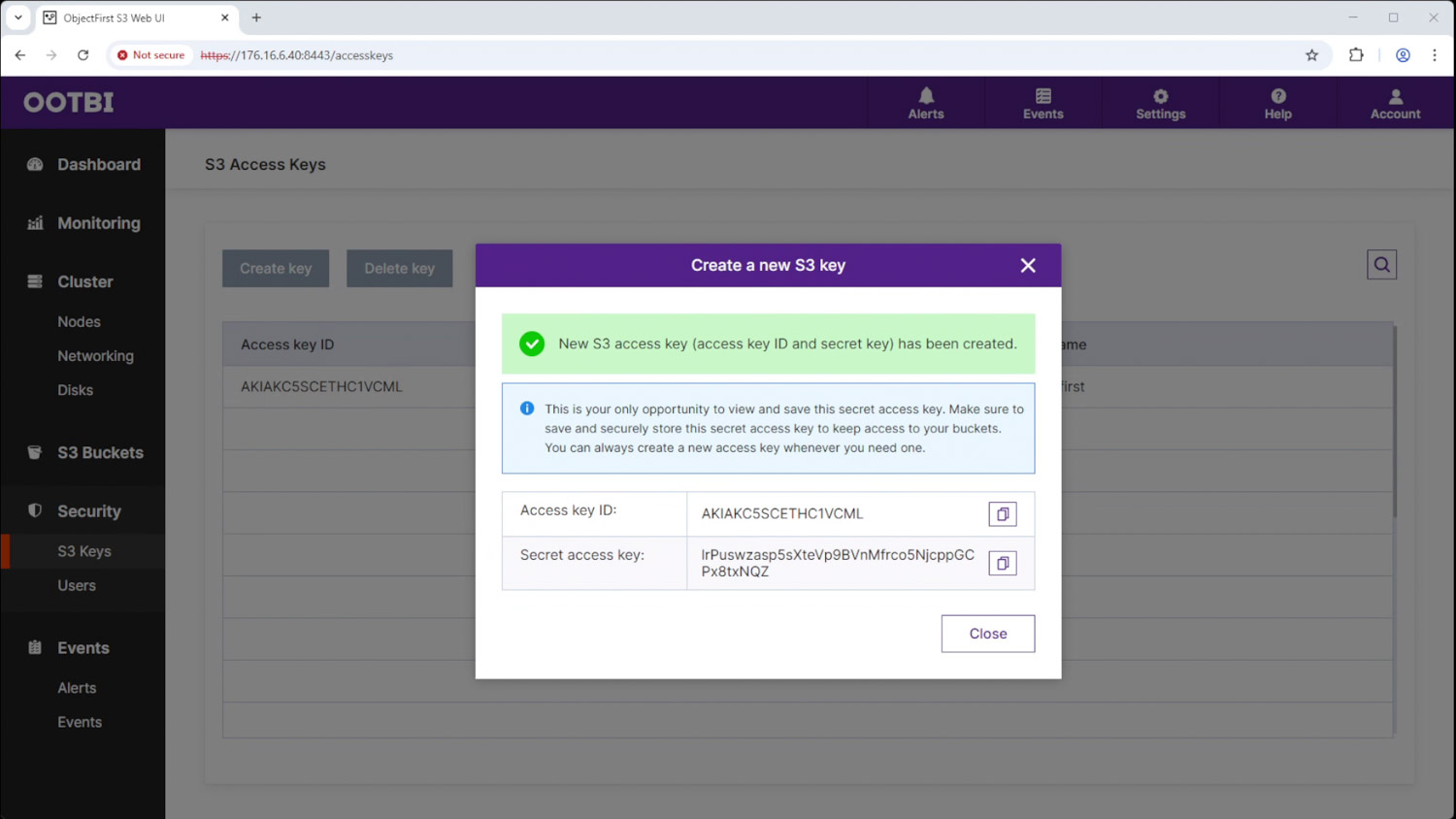
Keys and buckets follow a many-to-many relationship. Multiple keys can access multiple buckets. If a key is lost, new keys can be created for the same bucket.
Next, we move on to the S3 bucket creation step. The Ootbi appliance supports versioning, which enables immutability support. For our testing, we left this feature turned off; however, it prevents different attacks from deleting any data inside the bucket outside a timeline defined by your application.
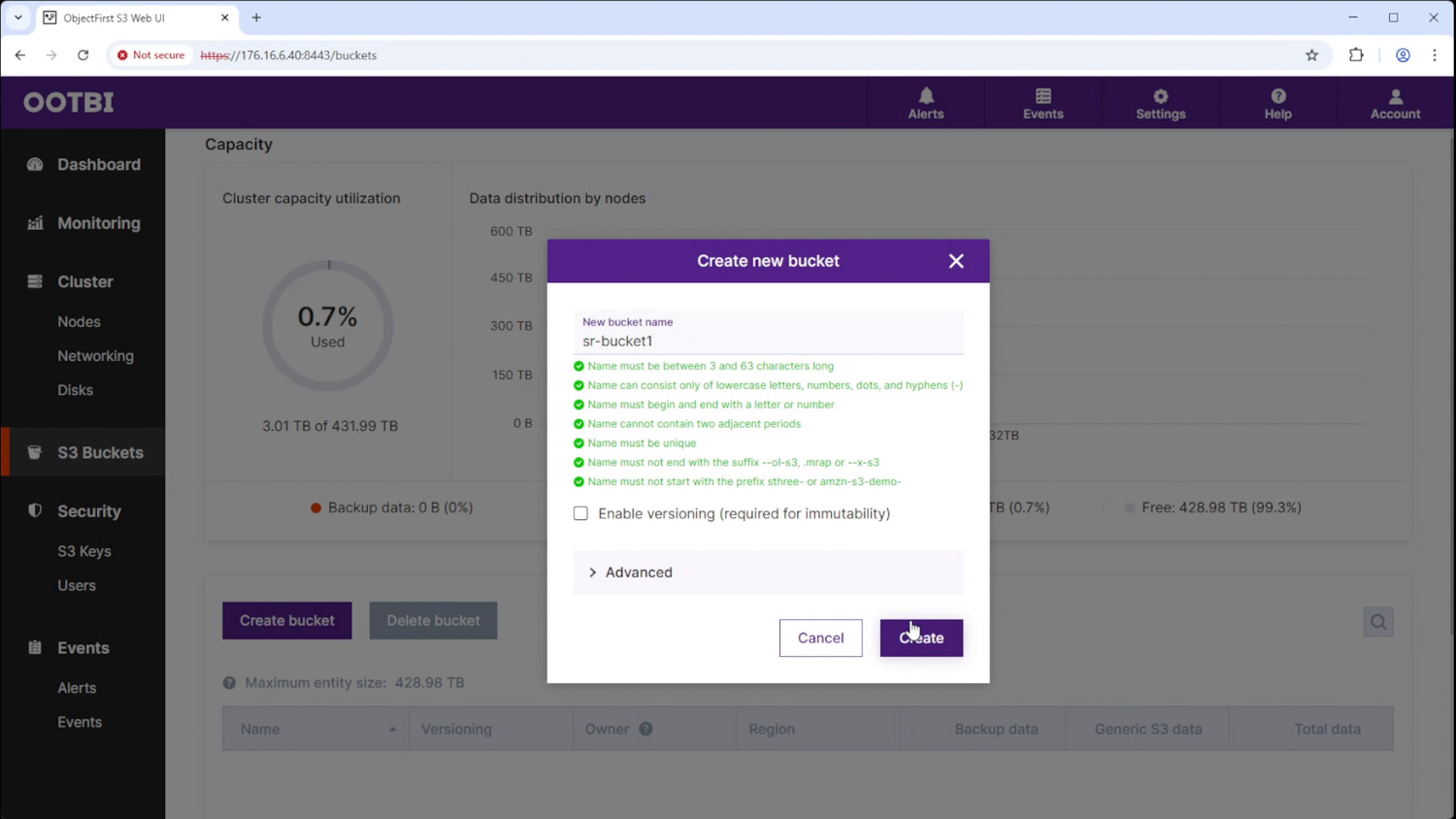
After creating the bucket, all configuration actions shifted to Veeam. We had a backup job ready to run, and within less than ten minutes, the backup data was transferred to Object First.
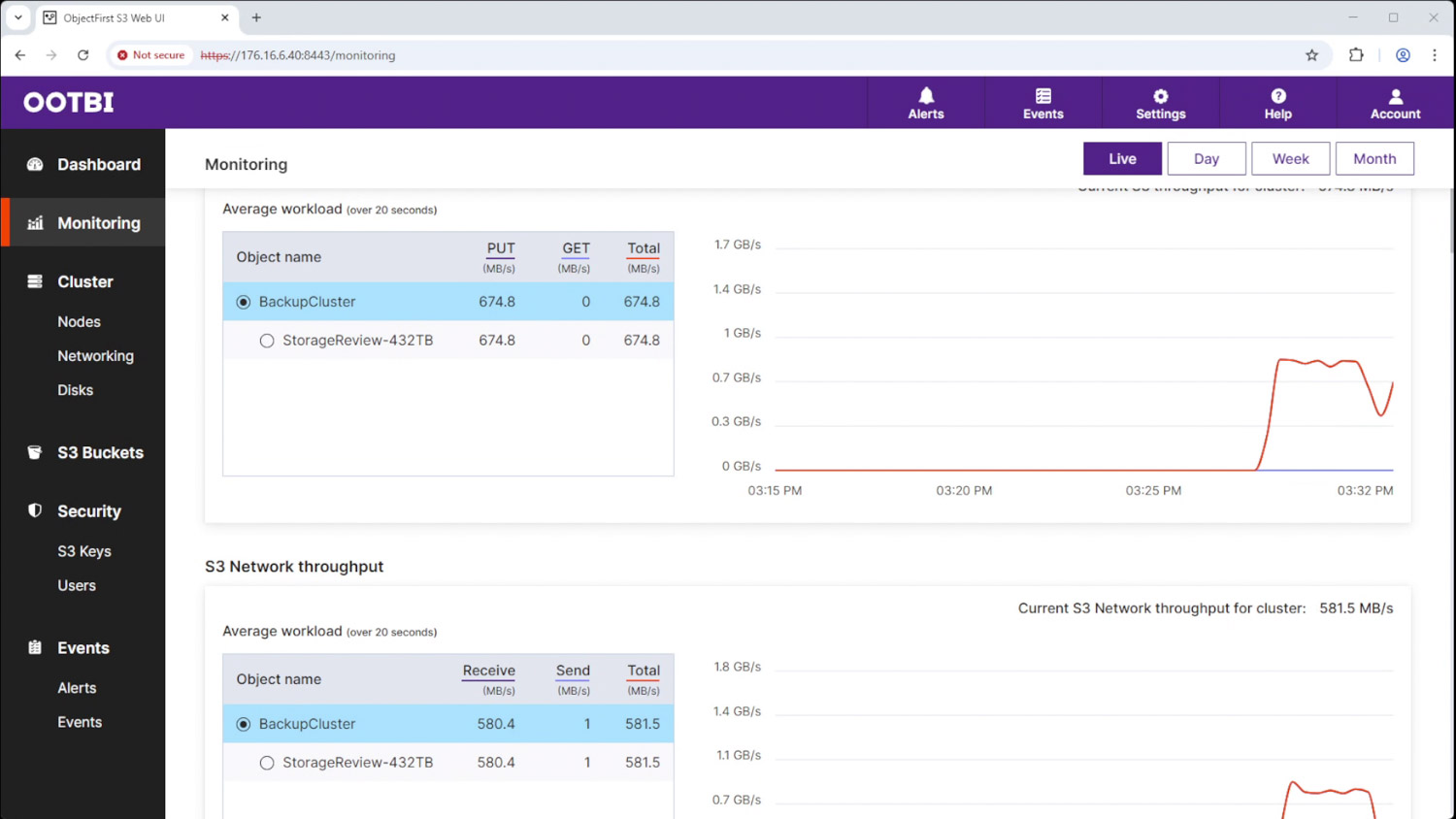
This ease of deployment is one of the core differentiators of the Ootbi platform. Whether it’s a mid-sized 20 TB unit or the high-capacity 432 TB model, the experience remains consistent: power it up, connect the interfaces, configure the network settings, and begin adding buckets. For customers working with a channel partner, much of this setup may never be seen. But for those opting to deploy independently, the system is designed to be exceptionally user-friendly, requiring no specialized knowledge or storage expertise.
Veeam Object Storage Configuration
Through the following configuration, we will utilize our dedicated lab Veeam server, which will connect our Ootbi appliance to an S3 repository. We began by creating a new backup repository in Veeam, specifically an S3-compatible object storage repository labeled “ObjectFirst-432TB.” Here, we can also set limits on the number of concurrent tasks that can run; however, for this example, no limit was set.
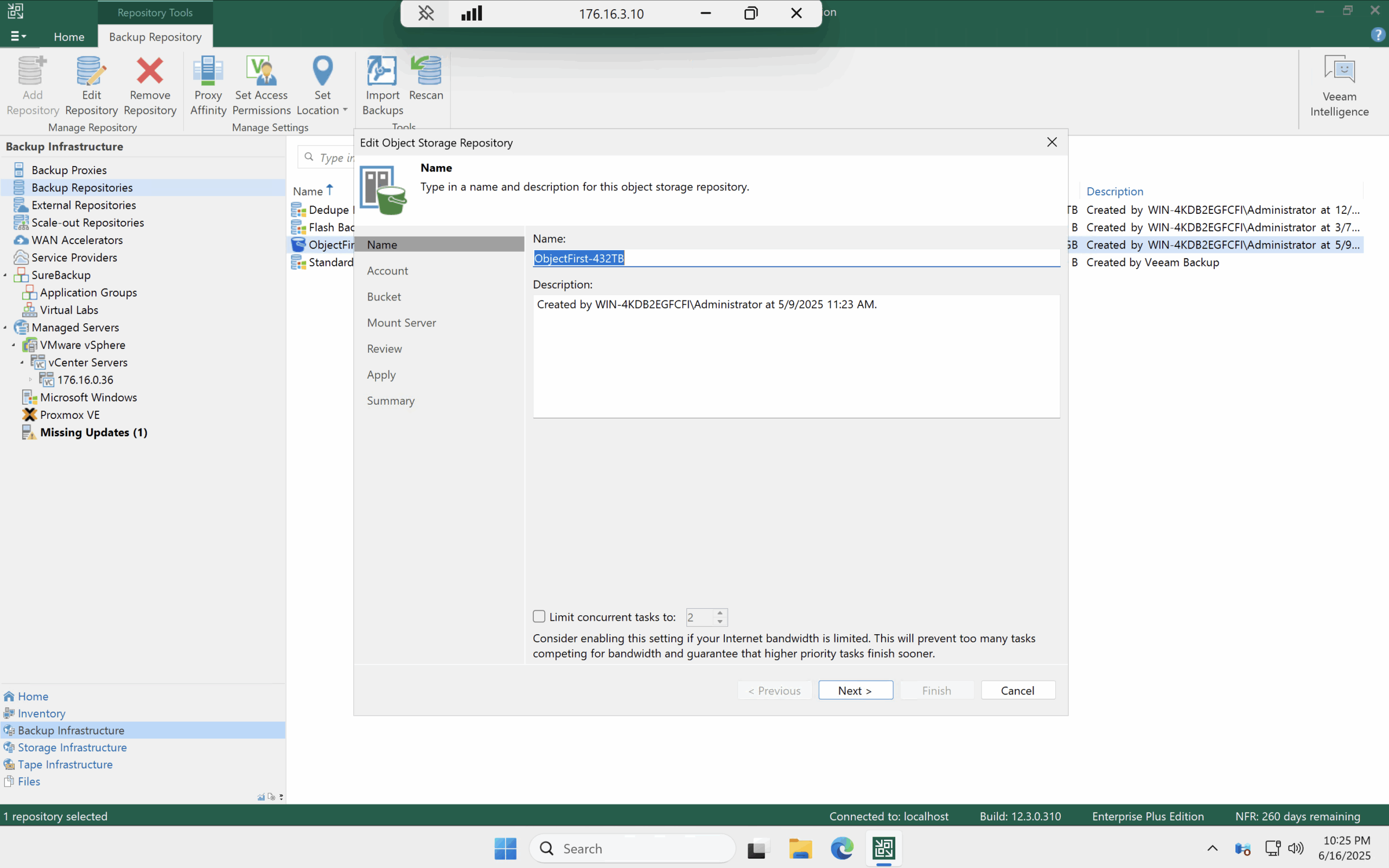
In the next step of creating an object storage repository, we provide the S3 credentials generated from the Ootbi appliance. This includes specifying the service point in URL format, such as https://176.16.6.40, and using the default region setting. Selecting “Add” under credentials allows you to enter the required Access Key and Secret Key to establish a secure connection.
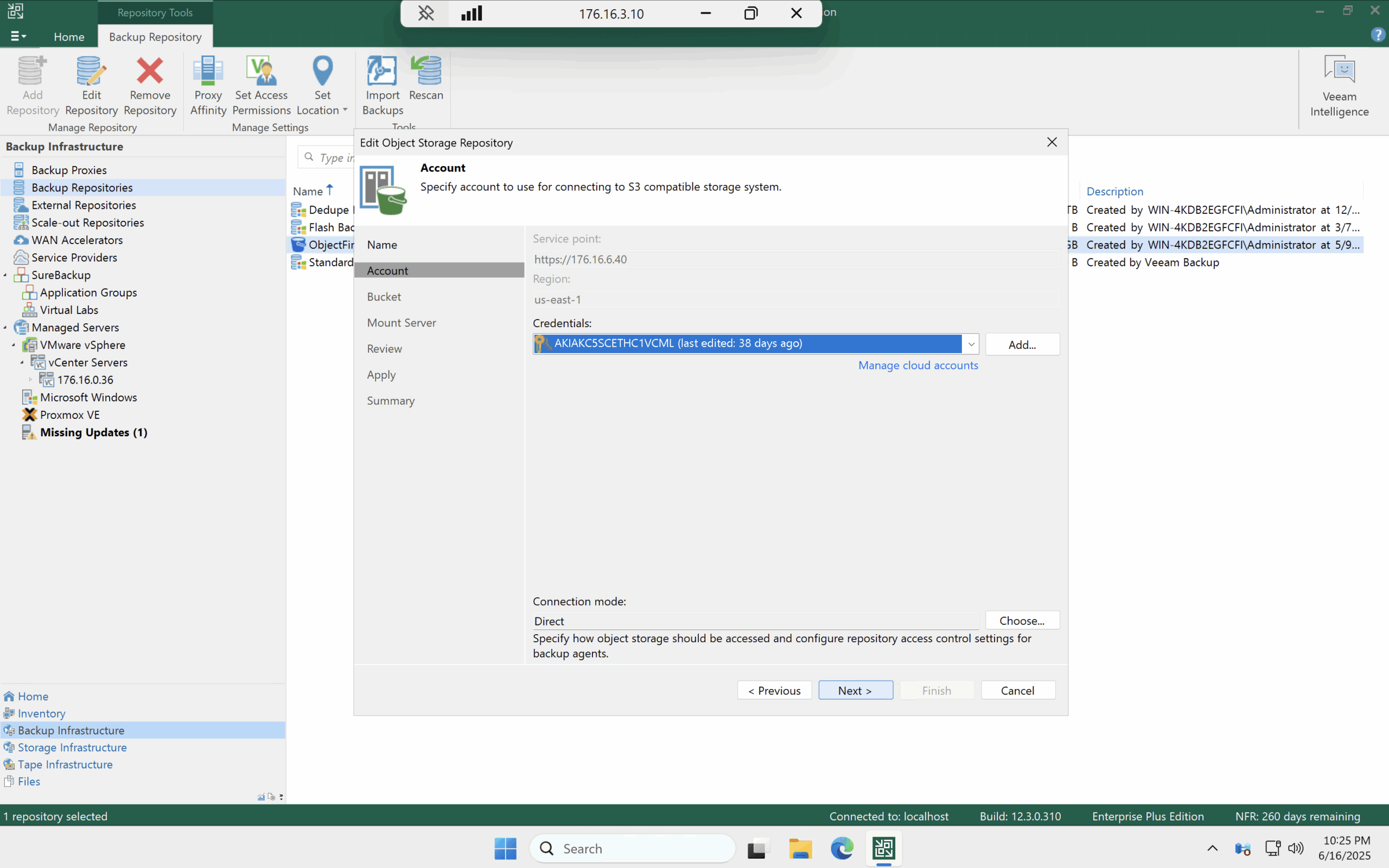
After a successful connection to the storage endpoint, the available buckets can be browsed. In our case, the bucket is named “sr-bucket1.” This step also provides options to limit object storage consumption and enable immutability for recent backups. For this configuration, we left both limits disabled.
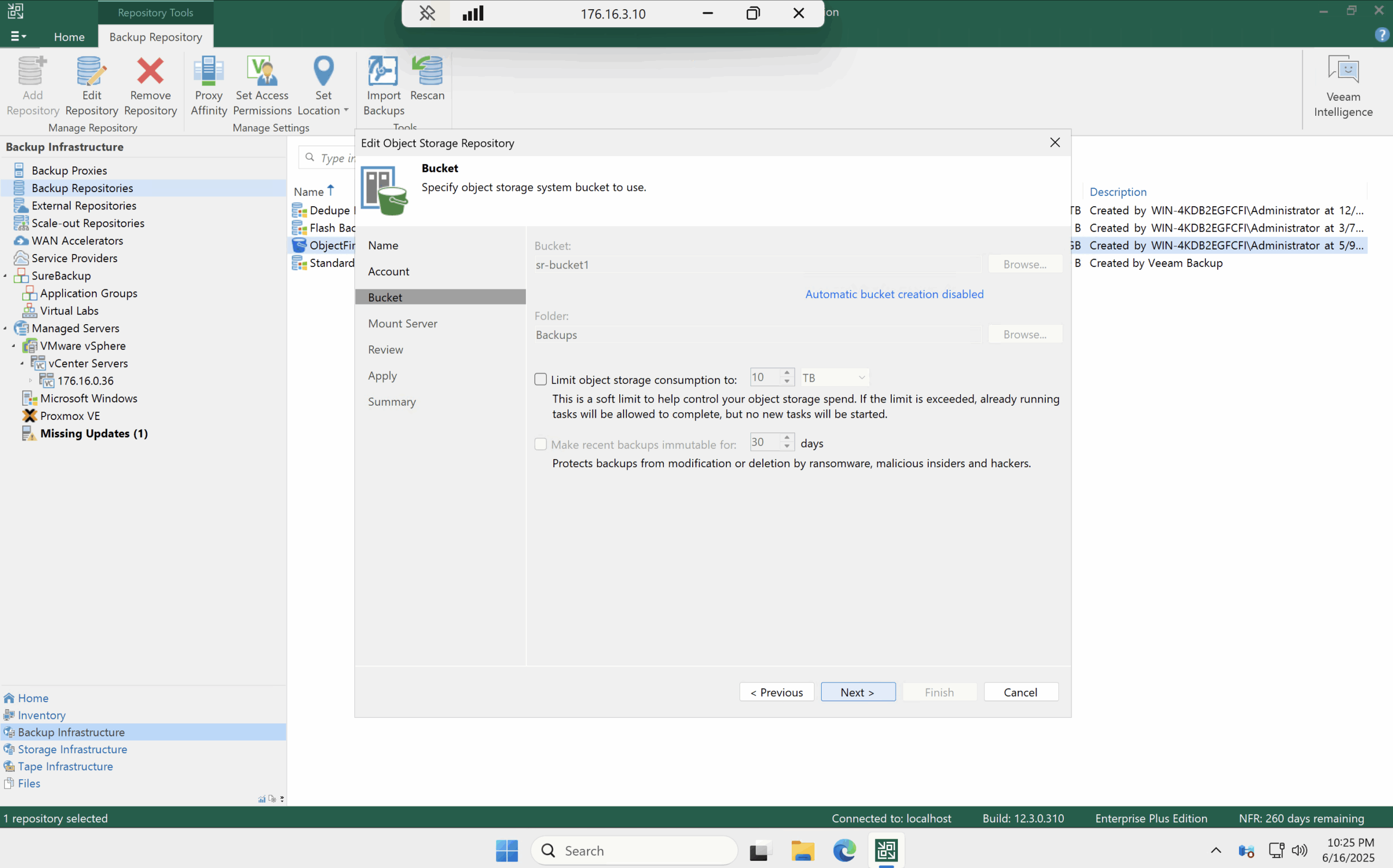
To support instant recoveries, we configured a write cache location and enabled the vPower NFS service. This allows Veeam to rapidly spin up virtual machines from backup without full restores, providing operational flexibility in recovery scenarios.
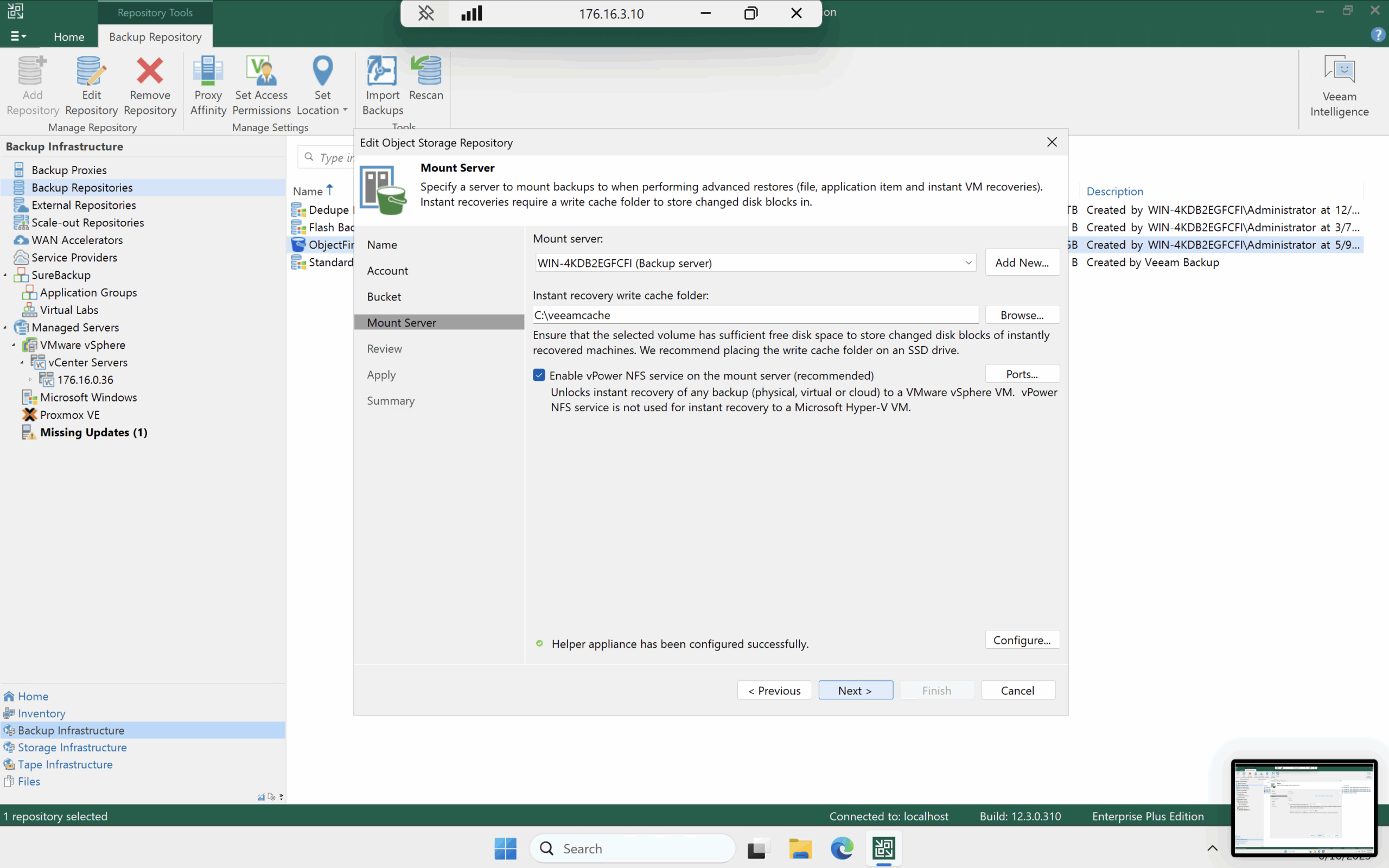
After the Mount Server tab, the final steps include the Review and Apply tabs. These are straightforward and primarily serve to confirm that all settings align with the intended configuration. Once completed, the repository reported full capacity availability, with over 389 TB free and 838 GB used. This confirmed successful provisioning and S3 compatibility with the 432 TB Object First appliance.
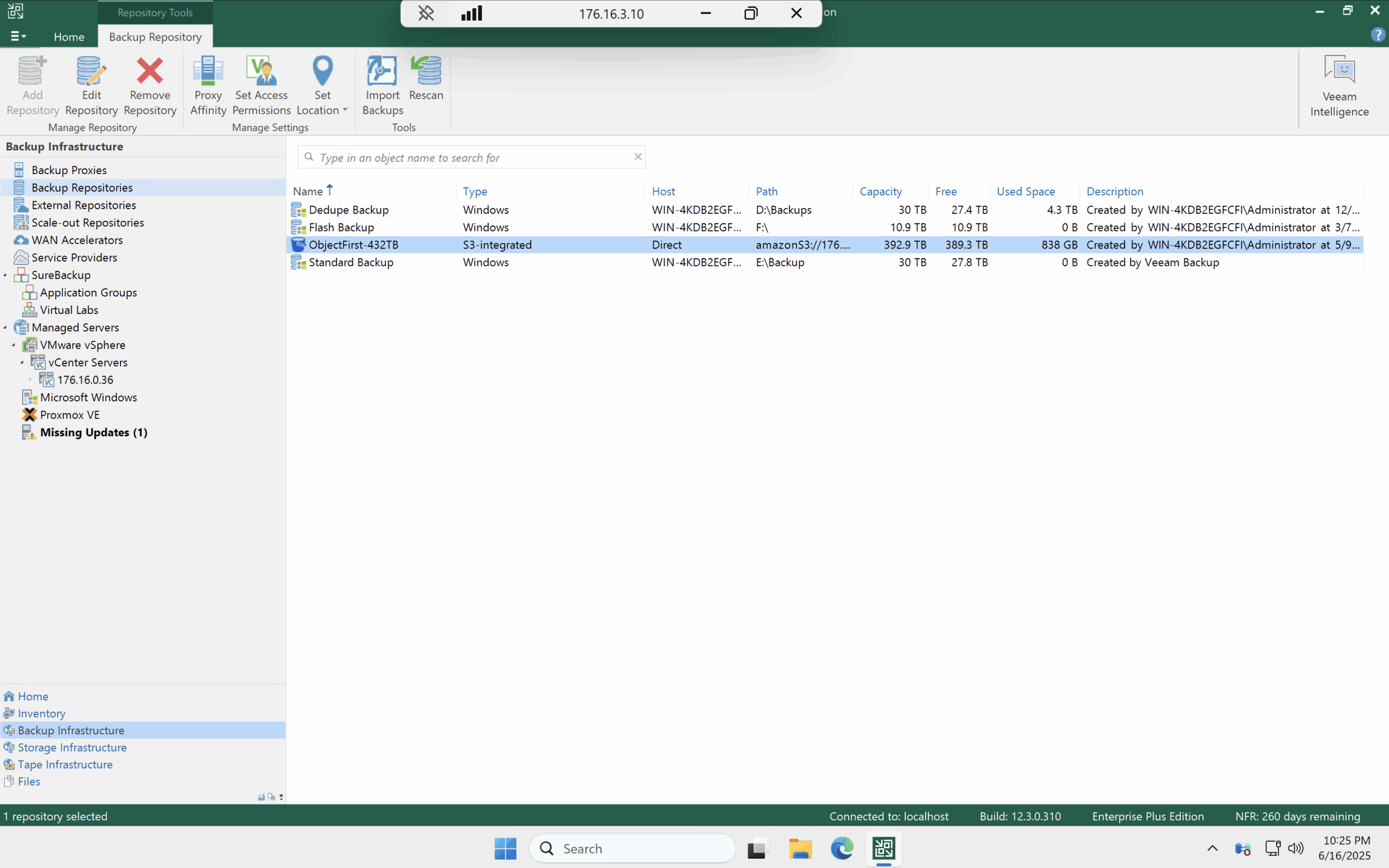
StorageReview Community VPS Server Veeam Backup Configuration
After creating the bucket, we can now set up a backup job that uses it as the storage target for our community VPS server. We begin this process by assigning the job a name, such as Proxmox-Backup.
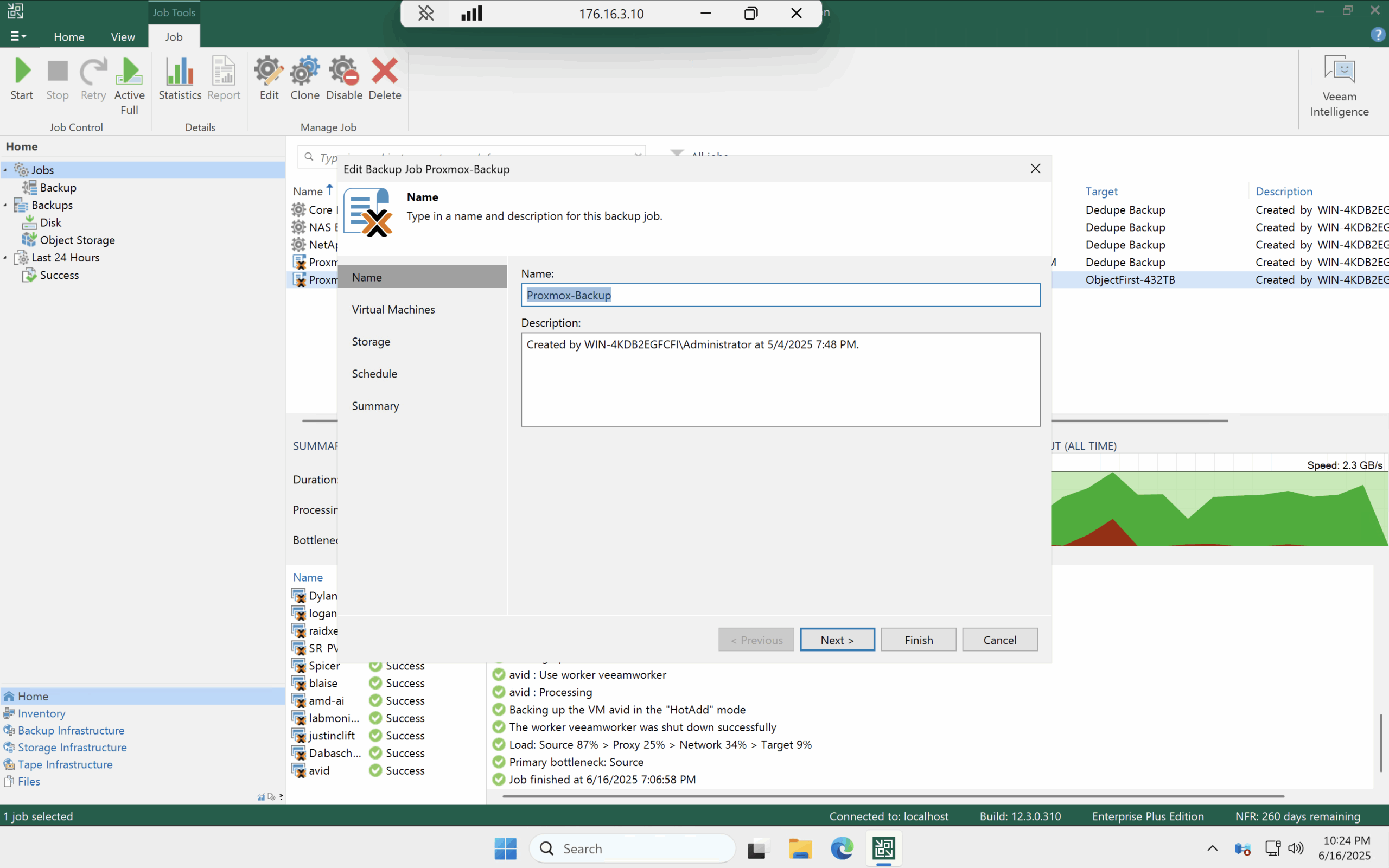
In the Virtual Machines section, we can select from our inventory of available Proxmox virtual machines. This section also displays the total size of each machine’s disks.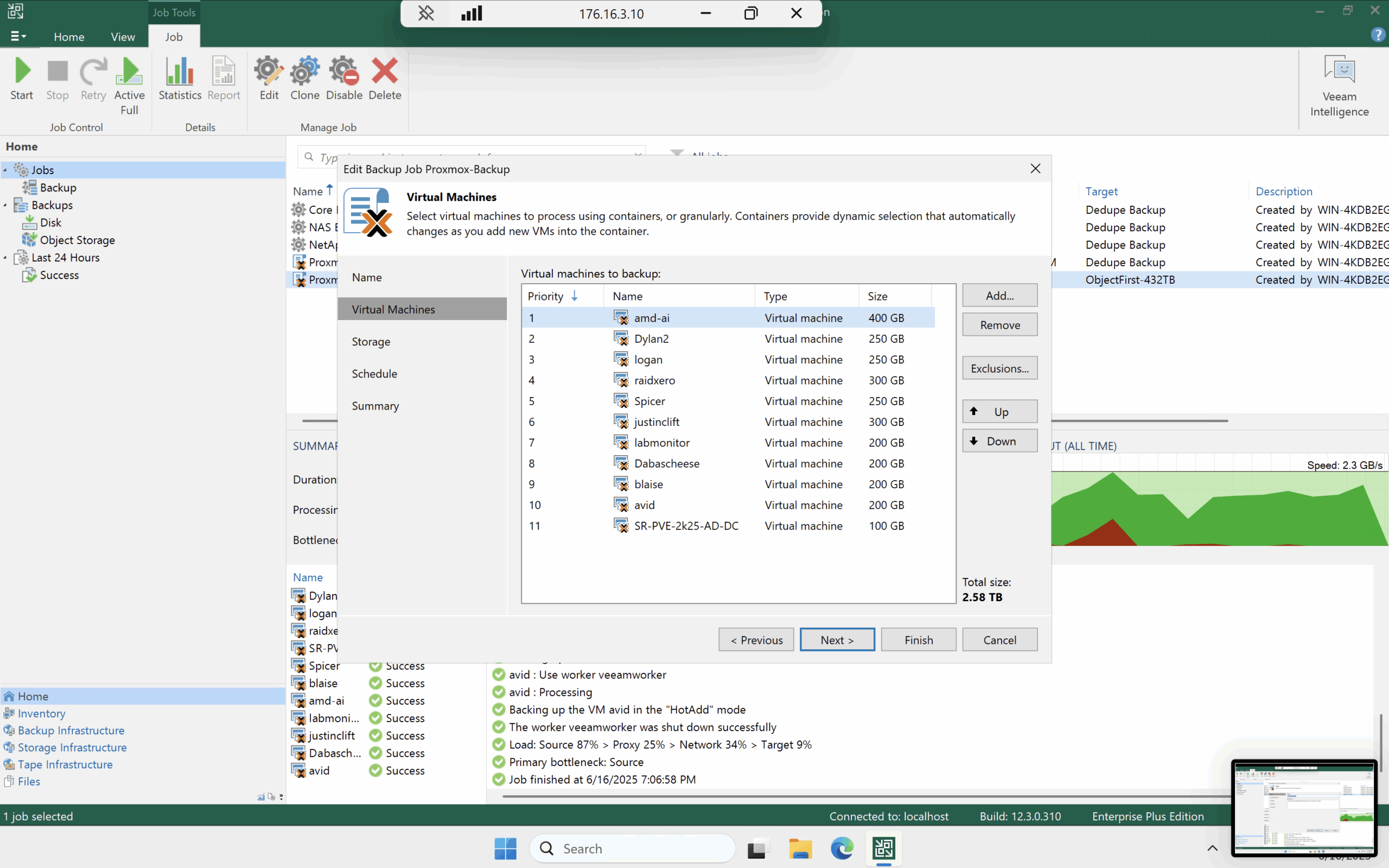
For the storage selection, we can choose the new ObjectFirst 432 TB repository we just created. In this example, we’ve set a retention policy of seven days. Additional advanced configurations are also available here, including options for compression and deduplication, backup mode, and other settings.
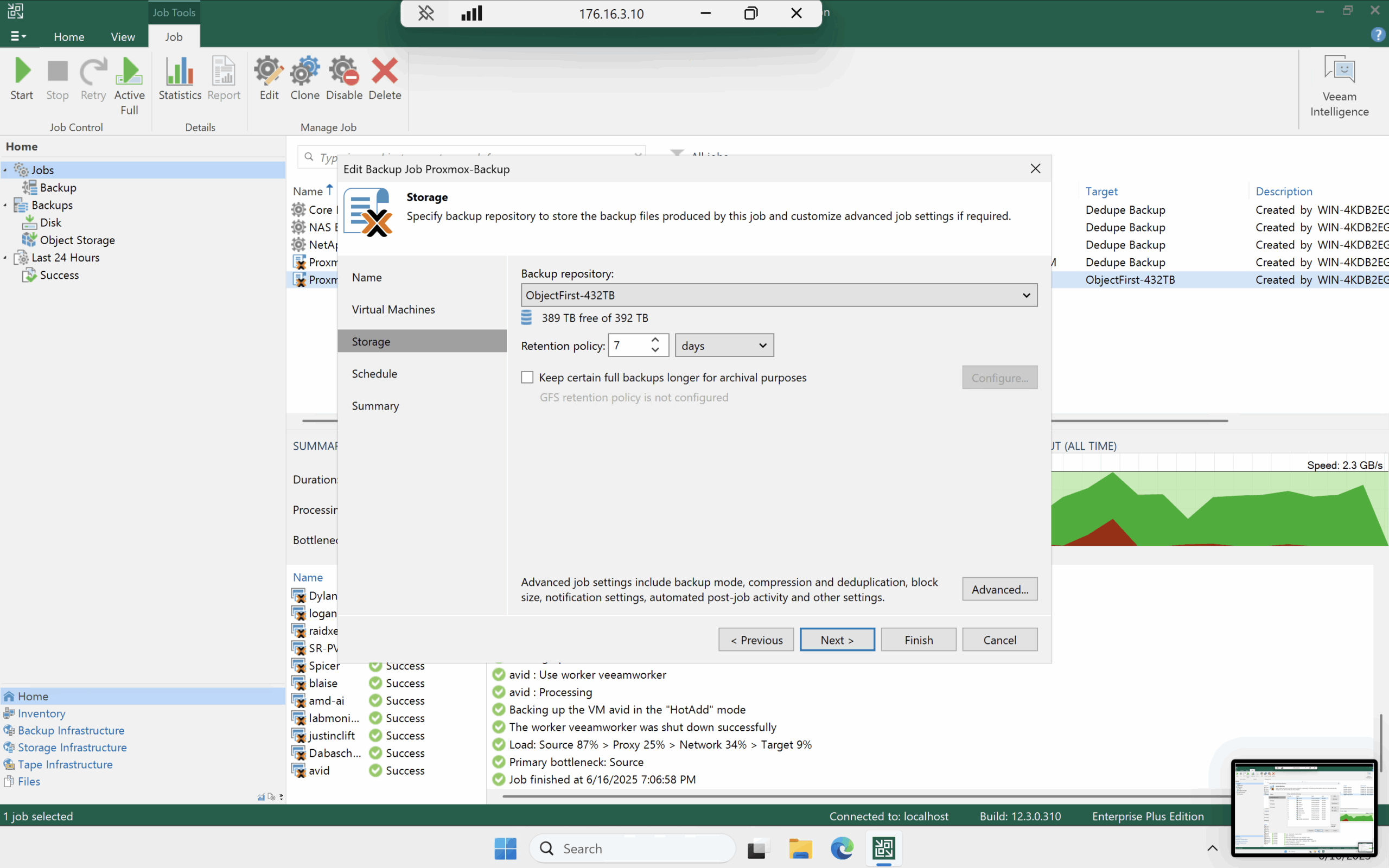
After the backup job is created and scheduled to use the Object First 432 TB repository, we can monitor its performance and status in the Veeam console. In this case, the “Proxmox Backup” job was completed successfully, backing up 11 virtual machines hosted in a Proxmox VE environment. The job took six minutes and 56 seconds to complete, with an average processing rate of 1.4 GB/s. A total of 436.2 GB of data was read and processed, while only 31.1 GB was transferred to the repository.
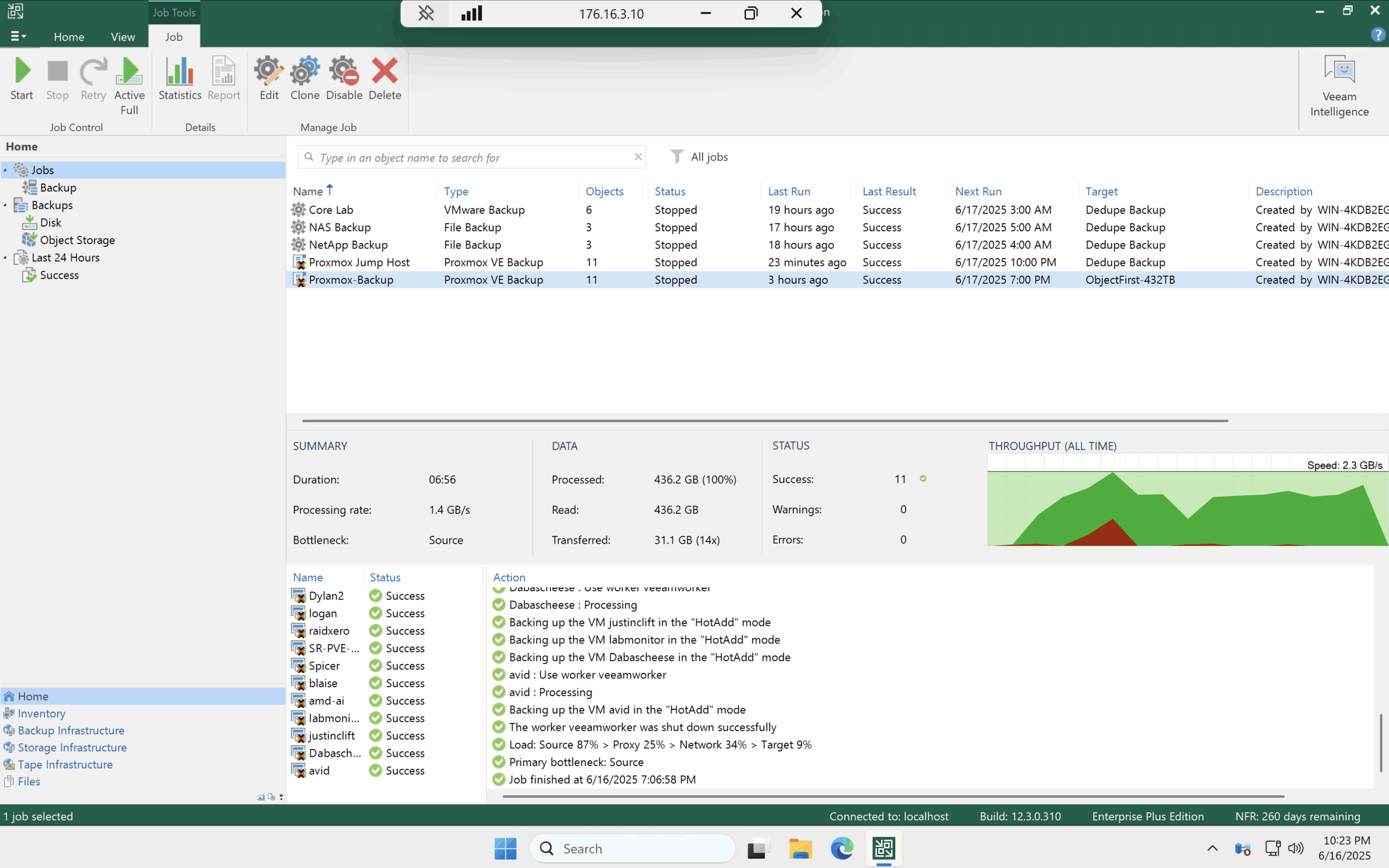
This reduction in transferred data is due to incremental backup behavior rather than just deduplication or compression. The primary bottleneck was identified as the source, indicating that the read performance from the virtual machines or the underlying storage was the limiting factor. All 11 machines reported a successful status, and the action log shows that HotAdd transport mode was used throughout the job. This allows Veeam to back up the virtual machines by attaching their disks directly to the proxy server for efficient processing.
The throughput graph on the right in the image above shows consistent data flow during the job run, with performance peaks reaching up to 2.3 GB/s and no major interruptions. This confirms that the backup job is functioning correctly and effectively utilizing the Object First appliance through S3-compatible object storage integration.
Day 2 Ootbi Management
Object First continues to emphasize simplicity not only in deployment, but also in ongoing management and maintenance. Software updates are handled through a streamlined web interface, requiring only a few clicks to apply. There is no need for command-line interaction or complex scheduling. In clustered environments, updates are automatically applied across all nodes in the cluster, ensuring consistent versioning without additional effort. We have seen several updates as Object First continues to enhance the platform and address any anomalies.
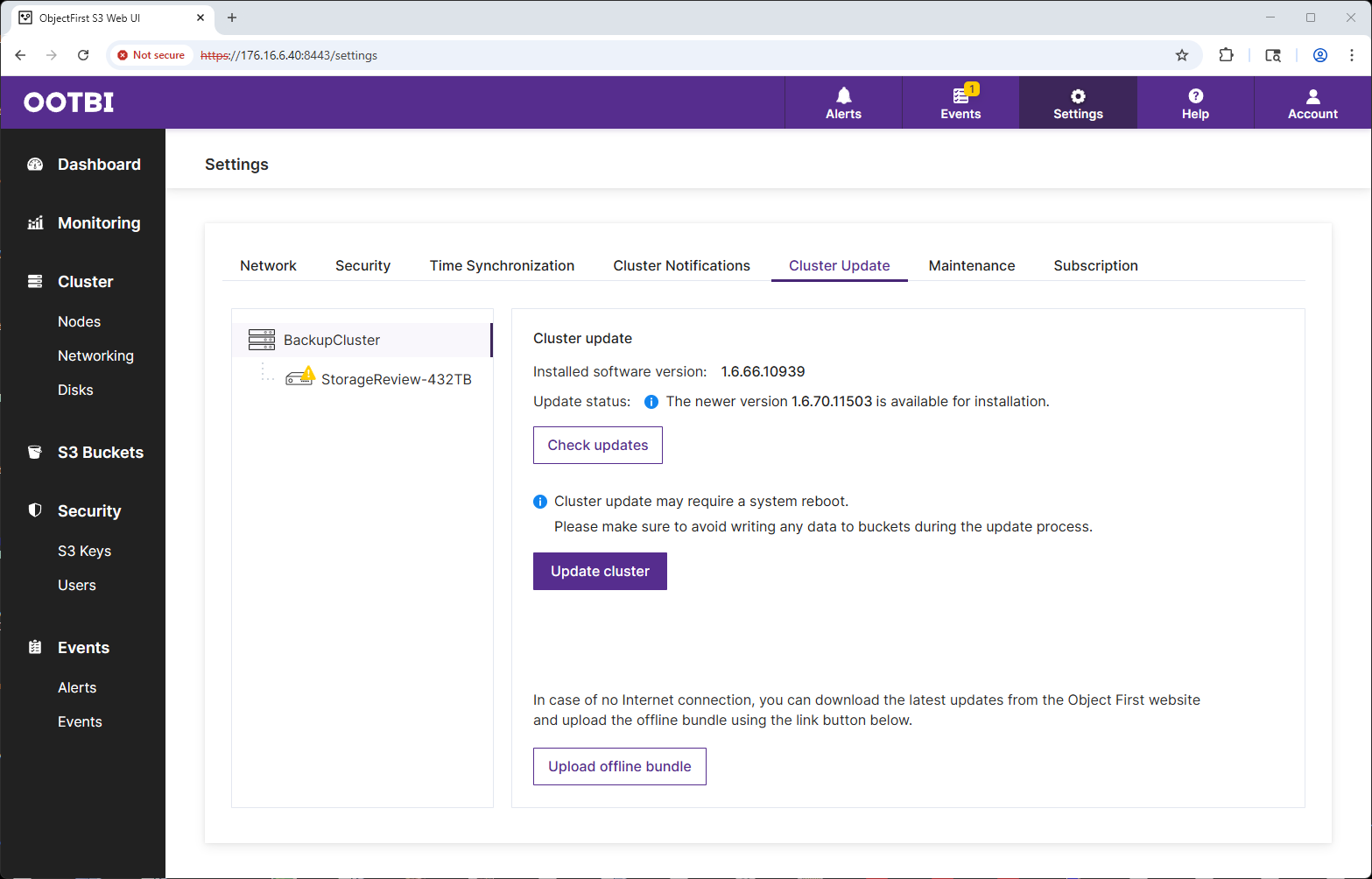
Updates can be completed in minutes, allowing administrators to quickly benefit from the latest security patches, performance improvements, and new features without disrupting operations. In most cases, updates are completed without downtime, and the appliance is back to handling backup jobs immediately after reboot, if required.
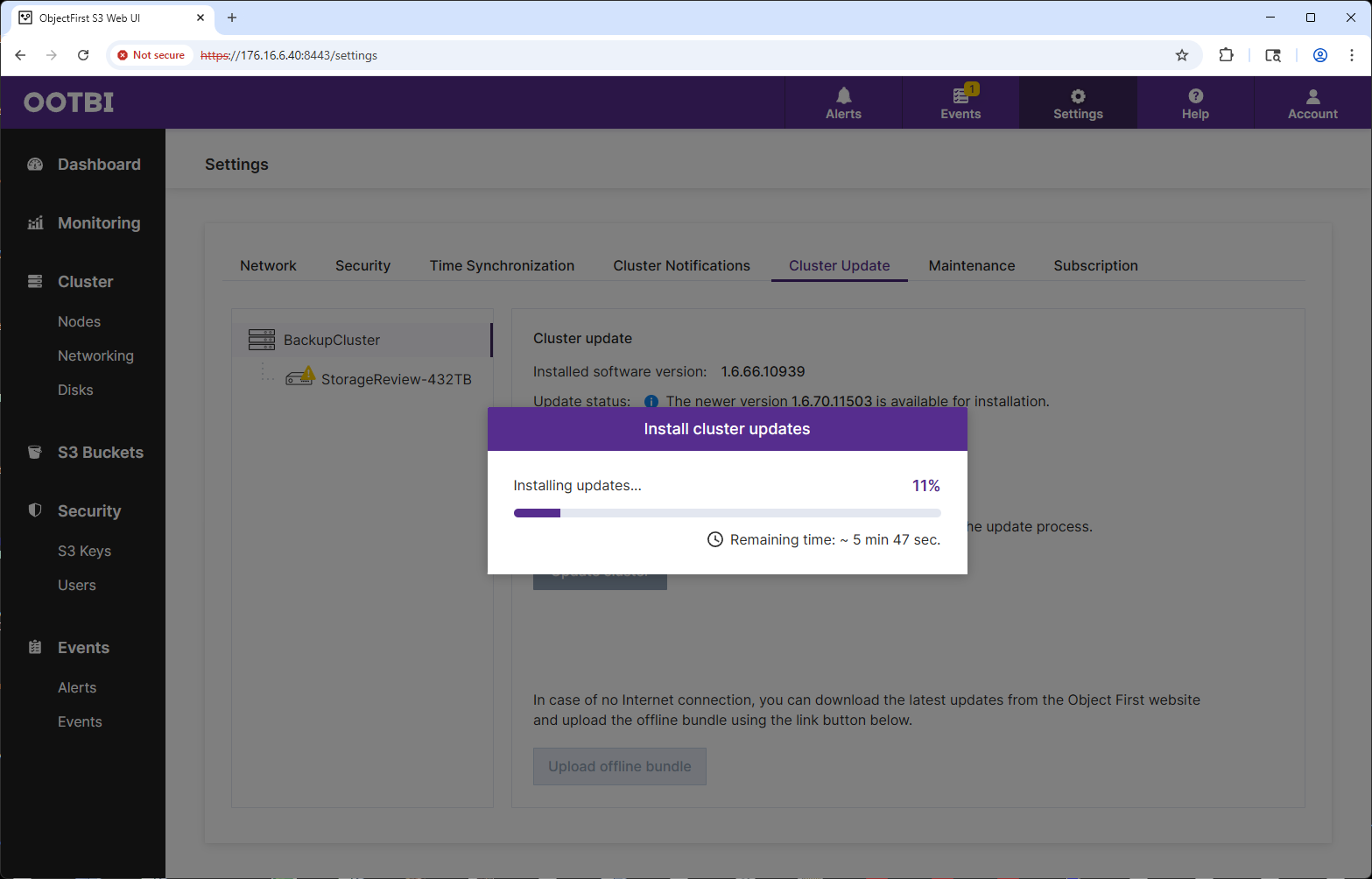
This ease of management reinforces Ootbi’s appeal to organizations that want to deploy secure backup infrastructure without investing in specialized training or operational overhead. Features such as role-based access control, Two-Factor Authentication (2FA), and detailed system health monitoring are available through an intuitive Web UI, enabling IT generalists or backup administrators to manage appliances with confidence. Whether handling daily operations or performing version upgrades, Ootbi delivers a predictable, low-friction experience that aligns with its goal of making ransomware-proof backup storage truly accessible.
A new feature has been added to the web interface, under System > Cluster Notifications > Syslog Notifications, which now enables syslog support. This feature allows for the sending of alerts and logs to platforms like Splunk by simply adding a new server and specifying its FQDN or IP address. You can also filter which logs are sent based on severity, helping to eliminate unwanted noise.
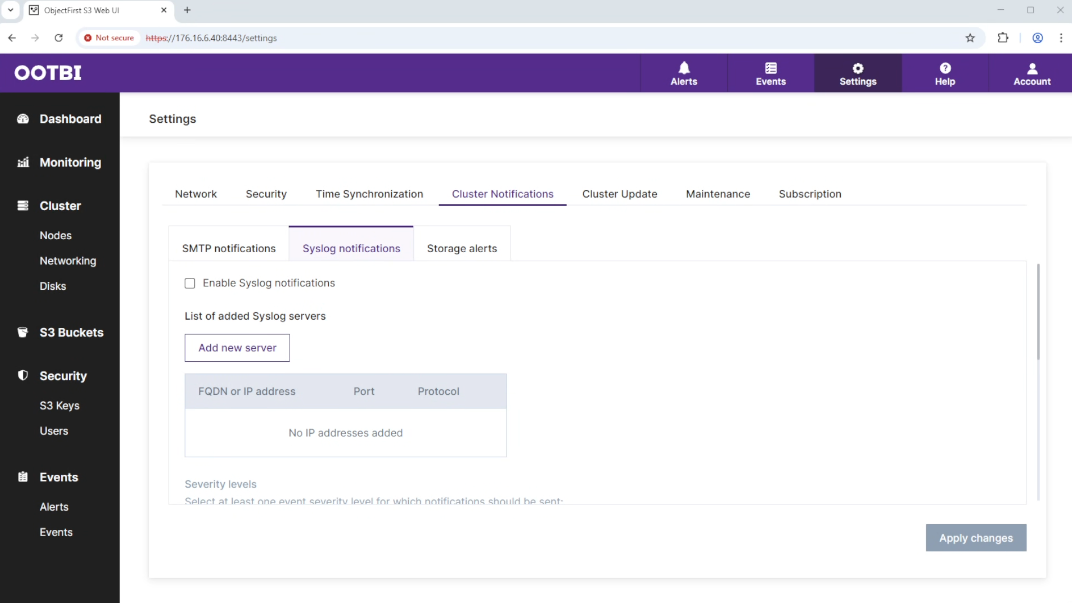
Another new feature in the same settings tab is Storage Alerts, which allows you to configure a free space alert threshold. By default, this is set to 80 percent, but it is adjustable between 60 and 90 percent based on user preference. In addition to these configurable alerts, Object First actively monitors usage trends and unusual consumption patterns. If potential issues are detected, the support team will proactively reach out to perform a health check and assist with reviewing the Veeam configuration to ensure optimal backup performance.
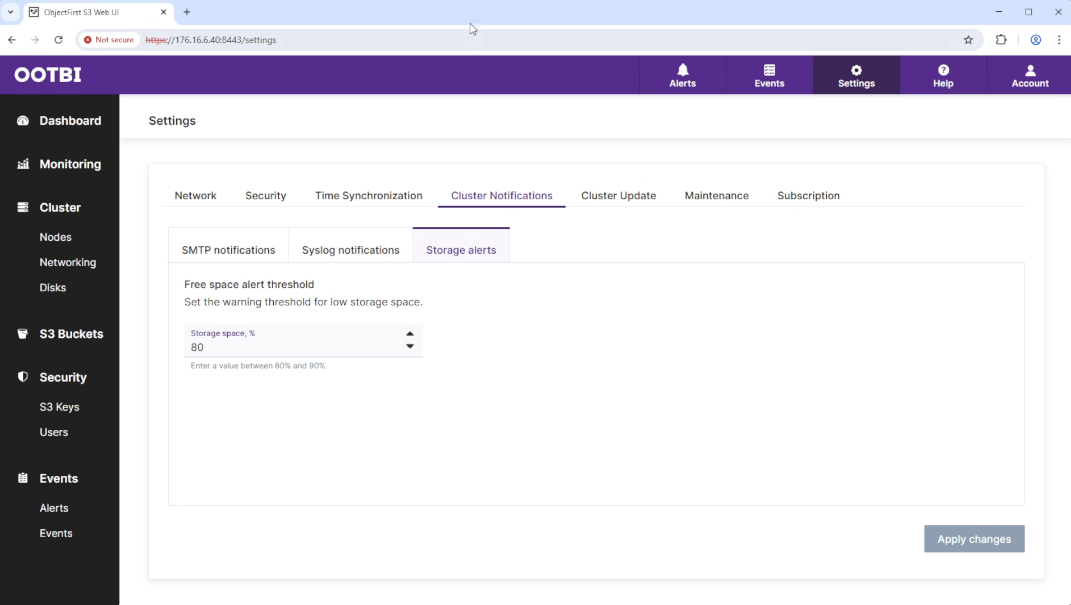
The following item is not new, but it has been relocated. Two-factor authentication (2FA) is now found under Account > Security, where it can be enabled. This update makes it easier for users to find and set up 2FA.
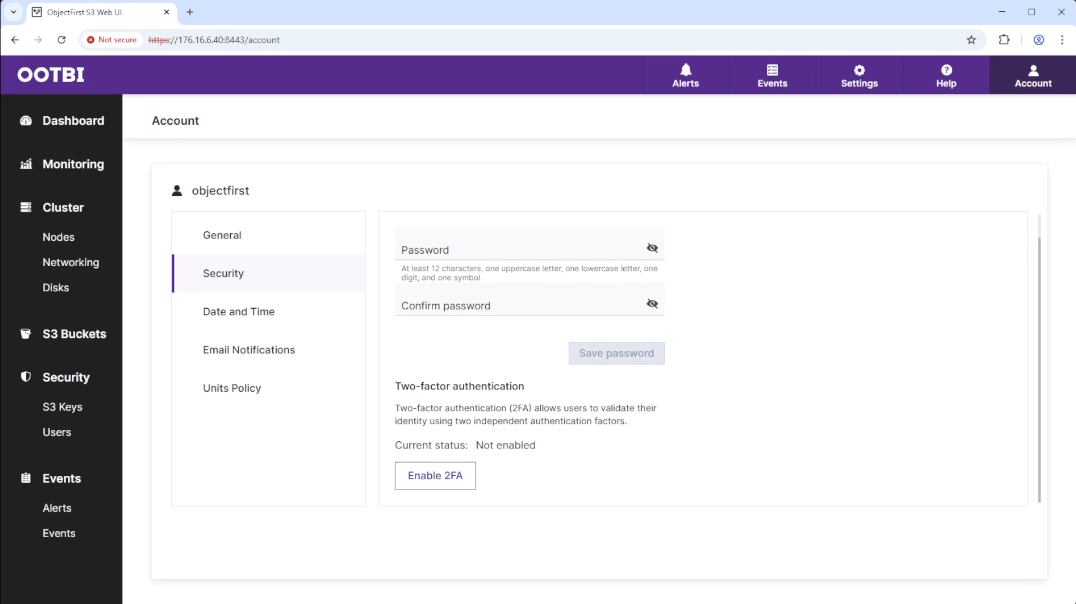
Telemetry with Object First: Proactive Monitoring for Ootbi Systems
Object First’s telemetry service plays a crucial role in maintaining the health and efficiency of Ootbi systems. By securely collecting and transmitting operational data over HTTPS (port 443), telemetry enables real-time monitoring of hardware and software performance without ever accessing backup contents or credentials. It helps detect anomalies, simplifies troubleshooting, and shifts the administrative burden from IT teams to the Object First support staff.
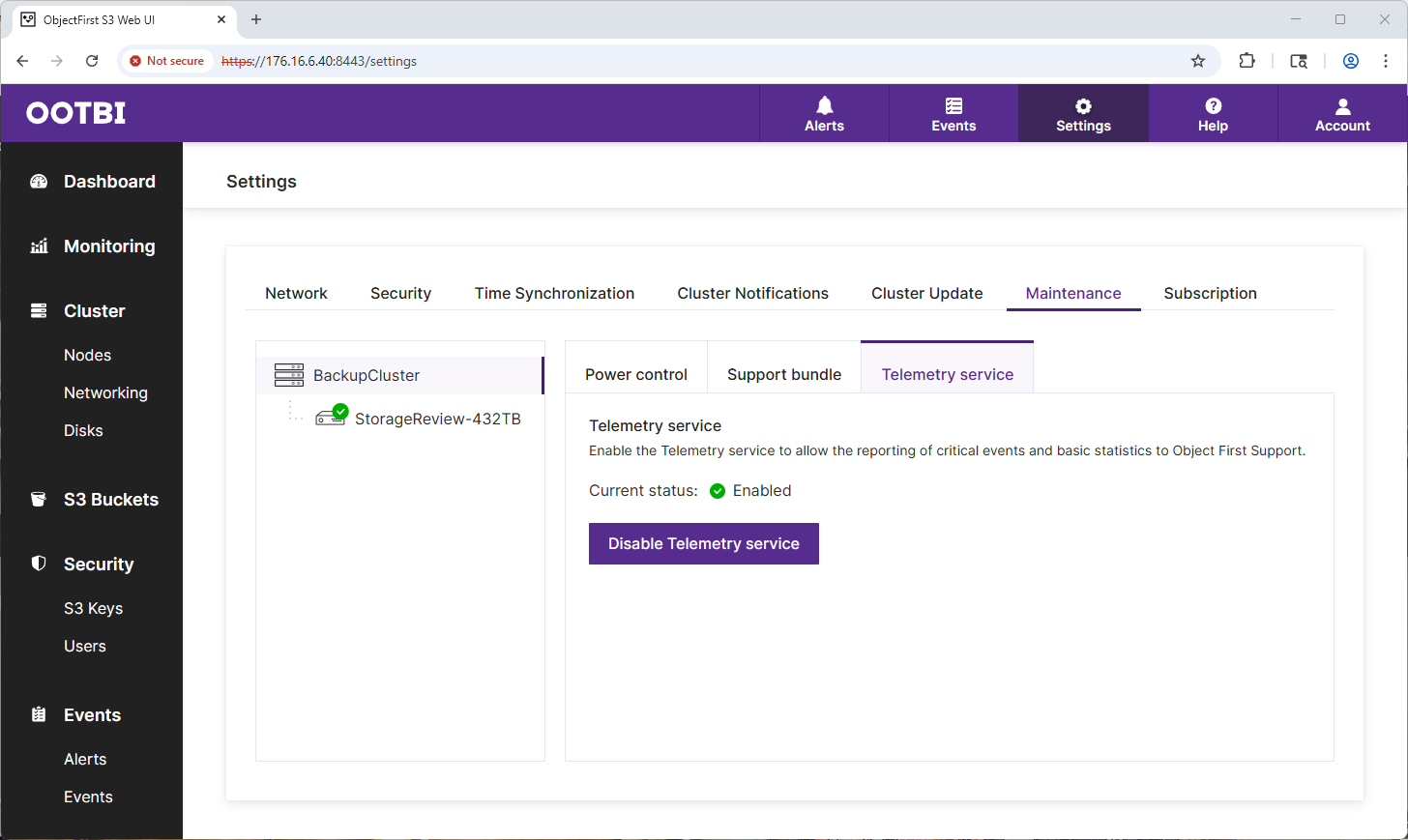
Key Data Collected:
- Hardware Status: Disk health, RAM usage, network interface alerts
- System Monitoring: S3 and cluster activity, capacity utilization, service logs
What’s Not Collected:
- No user backup data, authentication details, or sensitive content
- No remote access, all communication is outbound-only and encrypted
Benefits of Enabling Telemetry:
- Faster issue resolution and proactive problem prevention
- Automatic software update notifications
- Automatic service ticket generation on critical events
- Trend analysis to optimize capacity usage (not to upsell)
- Reduces manual intervention and IT workload
Object First recommends enabling telemetry on all supported Ootbi appliances. It’s free, secure, and designed to help customers achieve maximum reliability and efficiency from their immutable backup infrastructure.
Ready for Ransomware
As ransomware attacks continue to evolve in frequency and sophistication, organizations are facing increased pressure to demonstrate that their backup strategies can withstand real-world threats. This demand is not just operational; it is increasingly regulatory and contractual. Compliance frameworks, such as NIST SP 800-209, HIPAA, and PCI-DSS, all emphasize the importance of immutable backups and data segmentation as part of a broader zero-trust strategy. In parallel, cyber insurance providers are tightening policy requirements, often asking organizations to prove that their backups are protected against modification or deletion in the event of an attack.
Object First’s Ootbi appliances are well aligned with these requirements. The platform is built around out-of-the-box immutability, enforced at both the hardware and software levels. Even in scenarios where administrative credentials are compromised, Object First’s architecture ensures that destructive changes (deleting old backups after encrypting production data) cannot be made to backup data. This design directly supports compliance with immutability and data retention mandates. The version 1.6 software update has further strengthened access controls and monitoring by introducing role-based access control, expanding audit logging, and enhancing system observability to support audit readiness.
By simplifying the path to immutable, verifiable backups, Object First makes it easier for organizations to qualify for cyber insurance coverage or improve their standing with underwriters. For many organizations, this ease of implementation is just as valuable as performance or scale, especially in environments where backup infrastructure must meet both operational and regulatory requirements. Object First also delivers a high level of data protection, requiring minimal security expertise. For organizations that cannot afford or struggle to hire dedicated security staff, Ootbi offers a simple solution that can be deployed and managed by general IT admins or operations teams while still meeting modern security expectations.
Final Thoughts
The appeal of Object First’s Ootbi appliances lies in their ability to address one of the most pressing challenges in modern backup: achieving strong data resilience without increasing complexity. In our lab testing, we again saw firsthand how easy it is to deploy and operate the platform, and the market appears to be taking notice. The company’s continued success, highlighted by 167 percent year-over-year growth in global bookings, suggests that secure, purpose-built backup appliances for Veeam are gaining momentum across both the mid-market and enterprise segments.
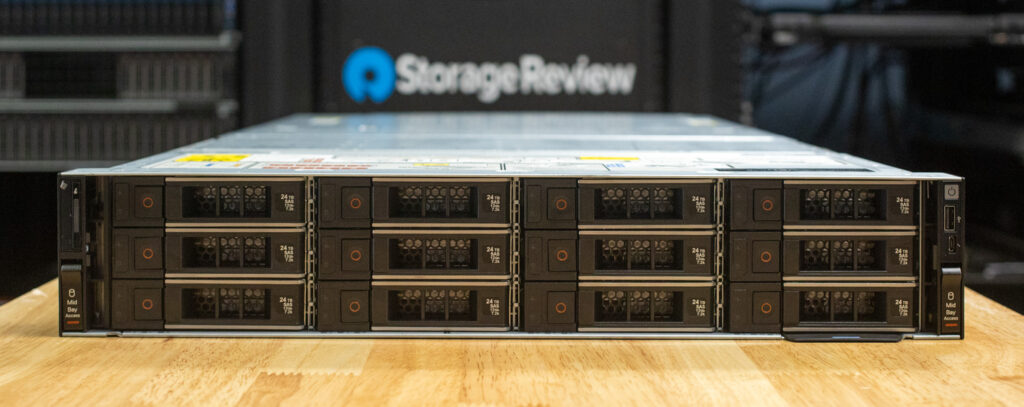
What is especially notable is how Object First has maintained a singular focus: building the best primary backup storage target for Veeam. This clarity has resulted in a solution that is not only effective but also practical. By offering appliances that do not require specialized knowledge to deploy or manage, Object First removes traditional barriers to implementing immutable storage. In contrast, alternative solutions often introduce more complexity due to either a lack of singular focus on Veeam from other vendors or DIY approaches that require deep expertise in procuring, configuring, and managing hardware while keeping systems up to date. The new consumption-based pricing model further extends accessibility, allowing customers and service providers to align costs with usage. For organizations looking to harden their infrastructure against ransomware without the overhead of building complex backup storage architectures, Ootbi presents a compelling option.
Channel growth and geographic expansion have also contributed to the platform’s adoption. Object First has added key distributors across North America and EMEA, reinforcing its go-to-market strategy through established partner networks. As more organizations prioritize secure and simplified backup strategies, the combination of purpose-built hardware, native S3 compatibility, and Zero Trust principles is proving to be more than just a niche. It is becoming a blueprint for modern backup resilience.
See Object First in action. Schedule a demo today and experience how simple ransomware-proof backup can be for your organization.
Engage with StorageReview
Newsletter | YouTube | Podcast iTunes/Spotify | Instagram | Twitter | TikTok | RSS Feed

